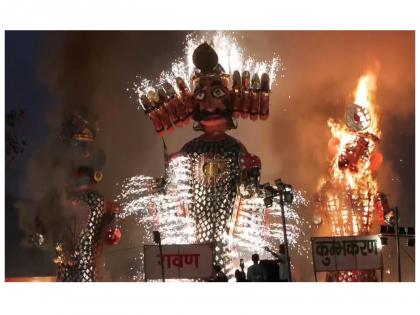From vibrant melas to Ravana Dahan: A look at how India celebrated Dussehra this year
By ANI | Updated: October 2, 2025 23:10 IST2025-10-02T23:08:26+5:302025-10-02T23:10:11+5:30
New Delhi [India], October 2 : This year, Dussehra is celebrated with immense enthusiasm and deep-rooted religious zeal in ...

From vibrant melas to Ravana Dahan: A look at how India celebrated Dussehra this year
New Delhi [India], October 2 : This year, Dussehra is celebrated with immense enthusiasm and deep-rooted religious zeal in India, drawing thousands of people who witness the symbolic burning of Ravana, Kumbhakarna, and Meghnatha's effigies, celebrating the timeless triumph of truth over evil.
In the national capital, President of India, Droupadi Murmu, attended Vijaya Dashmi organised by the Shri Dharmic Leela Committee.
She extended greetings on the occasion of Dussehra, saying, "Humankind thrives with the victory of good. When the demon of terrorism attacks humankind, it becomes essential to hunt it. Operation Sindoor by the Indian forces is a symbol of the victory of humanity over the Ravan of terrorism. For this, we bow before and thank every warrior protecting Bharat Mata."
Delhi Chief Minister Rekha Gupta also attended the Vijaya Dashami celebrations at the PU Block Ramlila Ground, Pitampura.
People celebrated the festival of truth over evil with the ceremony of Ravan Dahan in the states of Uttar Pradesh, Punjab, Haryana, Jharkhand and Madhya Pradesh.
Jammu and Kashmir also celebrated the festival with grandeur through the poignant ceremony of Ravan Dahan in Srinagar.
Himachal Pradesh Chief Minister Sukhvinder Singh Sukhu, attended the Ravan Dahan ceremony in Shimla.
In Himachal Pradesh, people celebrated Kullu Dussehra, which began on Vijayadashami with the traditional arrival of valley deities. Thousands of devotees gathered to witness the grand cultural and spiritual celebration in Kullu.
This year, thousands of people attended the Rath Yatra of Kullu Dusshera in Kullu.
Karnataka celebrated Mysuru Dasara, a grand and historic ten-day state festival, annually held in the city of Mysuru.
It is one of the most famous Dasara celebrations in India, renowned for its royal traditions, illuminated palace, and spectacular processions.
Karnataka Chief Minister CM Siddaramaiah and Deputy CM DK Shivakumar are also in attendance.
On the occasion of Dusshera, women in Jabalpur, Madhya Pradesh, celebrated the festival with Sindoor Khela before the Durga idol.
During the festivities, women applied vermillion to each other and began the ritual of Sindoor Khela. They bid farewell to the mother goddess, marking the end of her 10-day visit to her parents' home on Dusshera.
Meanwhile, the 1055 Artillery Regiment of the Border Security Force (BSF) deployed in Jaisalmer held a traditional 'Shastra Pooja' on the occasion of Vijaya Dashmi.
During the pooja, the soldiers worshipped the weapons, including those used during Operation Sindoor. They also offered flowers to the weapons with Shakti mantras, considering the firearms as deities.
Uttarakhand Chief Minister Pushkar Singh Dhami participated in the Dussehra celebrations and the Ravan Dahan ceremony organised at the Parade Ground in Dehradun.
Extending his warm greetings to all the people of the state on Vijayadashami, CM Dhami prayed to Lord Shri Ram to bless everyone with good health, a bright future, happiness, and prosperity.
Prime Minister Narendra Modi extended wishes on the occasion of Vijayadashami, calling the festival a symbol of the victory of good and truth over evil and untruth.
In a post on X, the PM wrote, "Vijayadashami is a symbol of the victory of good and truth over evil and untruth. My wish is that on this sacred occasion, everyone receives the inspiration to continuously progress on the path of courage, wisdom, and devotion."
"My warmest greetings of Vijayadashami to my family members across the country," the post read.
The 'Vijyayadashmi' or 'Dussehra', is celebrated to mark the triumph of good over evil. It is believed that Lord Rama killed Ravan on this day, and with this belief, the culture of burning the effigies of Ravan began. The 'Vijayadashmi' also marks the culmination of the nine-day-long Navratri festival.
It is observed on the tenth day of the month of Ashvin, the seventh in the Hindu Luni-Solar Calendar. The festival typically falls in the Gregorian calendar months of September and October. The festival also marks the start of preparations for Diwali, which is celebrated twenty days after Vijaya Dashami. Vijaya Dashami is celebrated with huge fervour across the country.
The effigy burning of Ravana, Meghnad, and Kumbhkaran is a popular tradition in many parts of India.
Disclaimer: This post has been auto-published from an agency feed without any modifications to the text and has not been reviewed by an editor
Open in app
